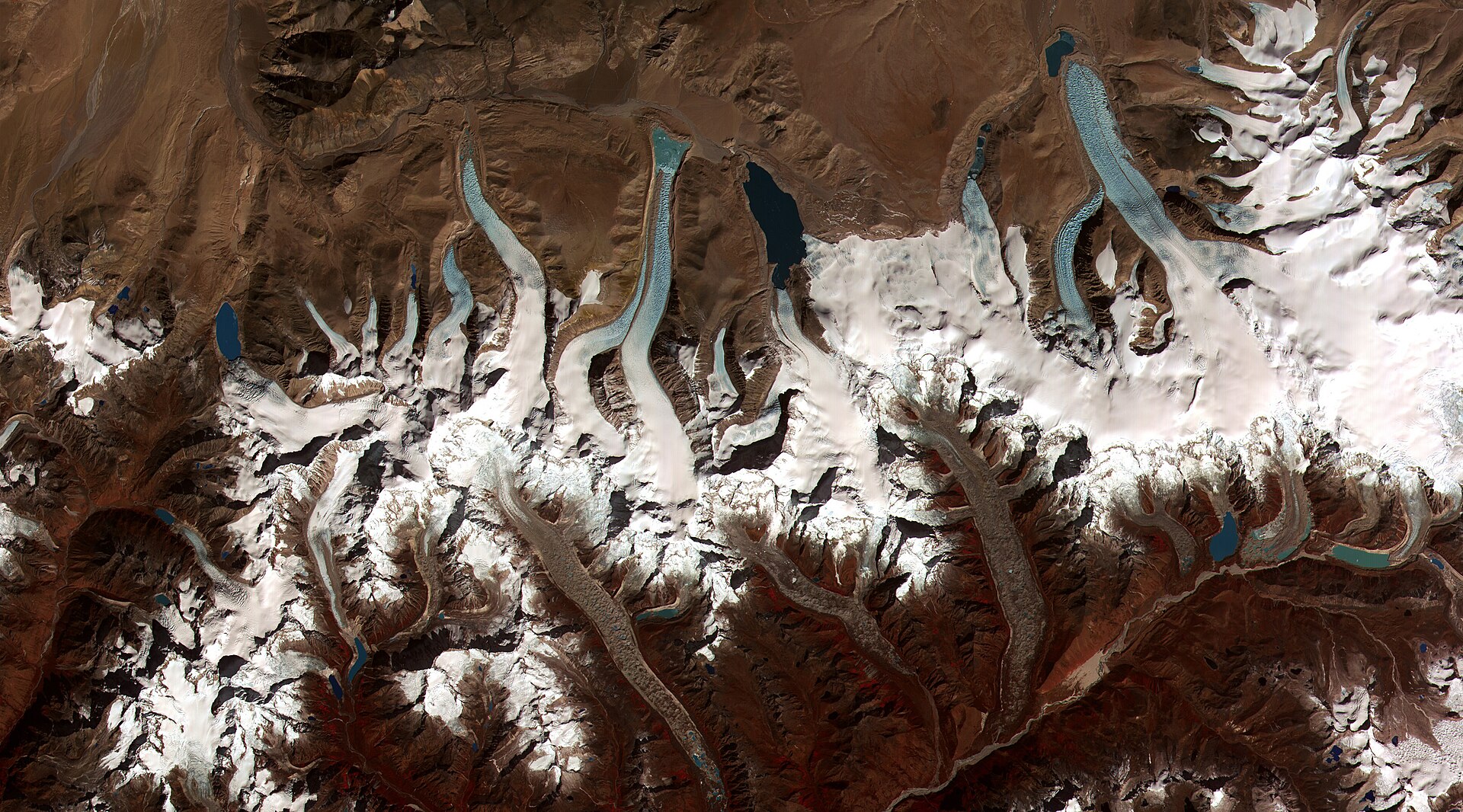The causes and impacts of the melting Himalayan glaciers
Find out why the Himalayan mountain range is so important and why the melting Himalayan glaciers are a cause for concern.

The Himalayas is a mountain range that’s home to many of the world’s highest peaks. Passing through India, Pakistan, Afghanistan, China, Bhutan and Nepal, this incredible span of geography is an important cultural and ecological location. However, climate change threatens the area, and the impacts of the melting Himalayan glaciers could be devastating.
We explore why this mountain range is so fascinating and essential, looking especially at its many glaciers. We also explore why these glaciers are melting and what the results of the changing Himalayan climate could mean.
An introduction to the Himalayas
First, let’s take a quick look at the mountain range itself. It’s a place that has significance to many and is firmly rooted in popular culture. However, given its size and scale, it’s often not understood especially well.
What are the Himalayas?
The Himalayas are a mountain system in South and East Asia that spans around 1,550 miles (2,500 km), running west-northwest to east-southeast in an arc. This huge geographical range means that climates in the Himalayas vary between humid and subtropical in the foothills to dry desert conditions in the higher reaches.
The Himalayan region is home to over 50 million people, yet an estimated 2 billion people rely on waters from Himalayan glaciers for drinking, energy, agriculture and more. Those who live there have their own distinct cultures, and there are various places of religious significance.
The Himalayan mountain range is also a biodiversity hotspot, home to a vast range of flora and fauna, including species such as snow leopards, Bengal tigers and one-horned rhino.
Where are the Himalayas?
As we’ve mentioned, the Himalayas covers many hundreds of miles. As well as stretching across the northeast portion of India, they also pass through Pakistan, Afghanistan, China, Bhutan and Nepal.
According to Britannica, the mountain range itself starts at Nanga Parbat (26,660 feet), in the Pakistani-administered portion of the Kashmir region, and ends at Namjagbarwa (Namcha Barwa) Peak (25,445 feet ), in the Tibet Autonomous Region of China.
How were they formed?
By mountain standards, the Himalayas are a relatively young range. They began to form around 40 to 50 million years ago when tectonic plate movement drove the landmasses of India and Eurasia together.
The pressure of the collision, and the fact that each continental landmass had about the same density, meant that the plates were thrust skyward, contorting the impact area and forming the jagged peaks of the Himalayas.
The modern Himalayas
Today, the Himalayas remain a culturally and environmentally important region. Many different people live in the Himalayas, and it’s a source of life for many of them. However, in recent years it’s also become a popular tourist destination.
Although tourism brings a range of economic and business opportunities and jobs, there are downsides. The effects on the environment, particularly with issues such as pollution, mean that the biodiversity of the area is under threat.
The Himalayan glaciers
Incredibly, there are 32,392 glaciers in the Himalayas. Together, they are part of intricate geographic and climate systems. Let’s find out more about them.
What is a glacier?
As we explore in our open step on the subject, glaciers are large bodies of ice, originally made from snow that accumulates over long periods of time. They vary greatly in size and can be as small as a football field or stretch for hundreds of kilometres.
Based on this, we can say that the definition of a glacier is a body of ice formed from the compaction of snow that moves downhill under its own weight. As you can imagine, for such a process to work, sustained low temperatures and snowfall are needed to create and maintain glaciers, meaning that they’re found either at high latitudes (the polar regions) or high altitudes (associated with mountains).

This map is generated from data provided by the Randolph Glacier Inventory. You will observe that ice is either found at high latitudes – i.e. the polar regions – or high altitudes – i.e. associated with mountains. Image courtesy of the National Snow and Ice Data Center, University of Colorado, Boulder, generated using data from the Randolph Glacier Inventory, GLIMS.
Why are they important?
So why do glaciers matter? Well, they play a central role in the world’s water systems, contributing to various elements of life. Glaciers:
- Provide drinking water. Approximately 75% of all of the world’s fresh water is locked up in glacier ice. Glacial melt provides drinking water for people in various places around the world, including the Himalayas.
- Irrigate crops. Throughout history, countries have used melting glaciers to water their crops and power their agriculture. Even today, communities still rely on glacial melt in this way.
- Generate power. It’s possible to use the meltwater from glaciers to power hydroelectric dams, providing electricity for the area.
It’s not just the immediate area that feels the impacts of glaciers. In the Himalayas, for example, the Indus, the Ganges and the Brahmaputra Rivers all originate from glaciers. These rivers provide water for countless millions of people.
The glaciers in the Himalayas
The Himalayas are home to the third-largest deposit of ice and snow in the world. Only Antarctica and the Arctic have more. These glaciers feed some of the planet’s most important river systems, directly and indirectly supplying billions of people with water, energy, and incomes.
Clearly, the Himalayan glaciers are an essential part of life for the eight surrounding countries, as well as further beyond. However, new studies have shown that the glaciers in the Himalayas are melting at an alarming rate. The consequences of this melt could be disastrous.
Why are the Himalayan glaciers melting?
The Himalayas in India and beyond have come under close attention in recent years. Several recent studies have shown that the situation could be much worse than originally feared. One study, in particular, found that if CO2 emissions are not cut drastically, around two-thirds of the Hindu Kush-Himalaya (HKH) region glaciers could disappear.
Glaciers in the Himalayas lost billions of tons of ice between 2000 and 2016, double the amount that took place between 1975 and 2000. Rising global temperatures are to blame – the result of carbon dioxide and other greenhouse gas emissions.
Air pollutants from unclean energy sources are also contributing. The dirty air then deposits black carbon dust on the ice. This dust means the glaciers absorb more heat and thaw more rapidly.
You can read more about measuring glacial change in our open step and learn about climate change and society with our online course.

The image above is a satellite image showing multiple retreating glaciers in the Bhutanese Himalayas. As a consequence of this retreat, proglacial lakes form in front of these glaciers.
The impacts of melting Himalayan glaciers
There are real concerns about the potential impacts of the melting glaciers in the Himalayas and beyond. Here are just some of the devastating effects of glacier loss on the surrounding regions:
- Increased flooding. As more meltwater enters the water system, proglacial glacial lakes form. However, these lakes are often unstable, and when the dams break, they can cause catastrophic glacier lake outburst floods (GLOFs). Similarly, more water in the glacier-fed rivers increases the risk of flooding.
- More extreme weather events. With more water and a warmer global temperature, the risk of extreme weather events increases. Scientists have already started to notice changes in temperature and precipitation extremes, for example.
- Changes in the monsoon. In Asia, the monsoon helps to support the livelihoods of millions of people. The annual rains are crucial to agriculture and water supplies. As global warming changes monsoon patterns, the risk of flooding during this season increases.
- Lower agricultural yields. Global warming means that snow and glaciers melt earlier in the year, leading to floods in spring. However, by summer, when crops need more water, volumes of water are decreased. As a result, agricultural yields are lower, arid zones increase, and fishing in the region is affected.
- Changes in energy production. Further downstream, the volume of water in dams may impact the production of hydroelectricity.
Ultimately, the melting Himalayan glaciers could cause real harm to the livelihoods of untold millions. Whether it’s changing weather patterns, extreme flooding, changes in food and energy production, or unpredictable water supplies, the risks seem very real.




How can we improve the situation?
So, the current and future danger of melting glaciers is evident. But what can we do to improve the situation? In reality, the only real solution is to prevent further global warming. There are many climate change solutions, and many of these focus on reducing your carbon footprint.
Although individuals can take steps to reduce emissions, governments and corporations need to make far-reaching changes to policies and practices. As we stand on the edge of a climate crisis, there is much work to be done to improve the situation.
Final thoughts
The Himalayan glaciers are crucial not only to the surrounding regions but also to the billions of people whose lives are affected by them. Recent global warming and climate change have seen these glaciers melting at an unprecedented rate, and the effects are devastating.
If you’re interested in learning more about the Himalayas glaciers, the environment, and climate change, we have a wide range of free courses available that can help. Our course on tackling environmental challenges for a sustainable future is an excellent place to start.




